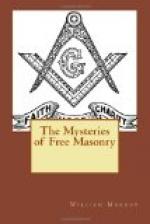In the Master’s degree is represented the assassination of Hiram by false brethren. This ought to put us in mind of the fate of Adam, occasioned by perverseness in his disobeying his great and awful Creator. The symbolic mystery of the death of Hiram Abiff represents to us that of the Messiah; for the three blows which were given to Hiram Abiff, at the three gates of the temple, allude to the three points of condemnation against Christ, at the High Priest’s Caiphas, Herod, and Pilate. It was from the last that he was led to that most violent and excruciating death. The said three blows with the square, gauge, and gavel are symbols of the blow on the cheek, the flagellation, and the crown of thorns. The brethren assembled around the tomb of Hiram, is a representation of the disciples lamenting the death of Christ on the cross. The Master’s word, which is said to be lost, since the death of Hiram Abiff, is the same that Christ pronounced on the cross, and which the Jews did not comprehend, “Eli, Eli, lama sabacthani,” “my God, my God, why hast thou forsaken me! have pity on and forgive my enemies.”—Instead of which words were substituted, M. B. N. (Mac-be-nac), which, in Arabian, signifies, “The son of the widow is dead.” The false brethren represent Judas Iscariot, who sold Christ. The red collar worn by the Grand Elect Perfect and Sublime Masons, calls to remembrance the blood of Christ. The sprig of cassia is the figure of the cross, because of this wood was the cross made. The captivity of the Grand Elect and Sublime Masons (i.e., by the Chaldeans), shows us the persecution of the Christian religion under the Roman emperors, and its liberty under Constantine the Great. It also calls to our remembrance the persecution of the Templars, and the situation of Jacques De Molay, who, lying in irons nearly seven years, at the end of which our worthy Grand Master was burnt alive with his four companions, on the eleventh of March, 1314, creating pity and tears in the people, who saw him die with firmness and heroic constancy, sealing his innocence with his blood. My dear brother, in passing to the degree of Perfect Master, in which you shed tears at the tomb of Hiram Abiff, and in some other degrees, has not your heart been led to revenge? Has not the crime of Jubelum Akirop been represented in the most hideous light?—Would it be unjust to compare the conduct of Philip the Fair to his, and the infamous accusers of the Templars, to the two ruffians who were accomplices with Akirop? Do they not kindle in your heart an equal aversion? The different stages you have traveled, and the time you have taken in learning these historical events, no doubt, will lead you to make the proper applications; and by the degree of Master Elect and Kadosh, you are properly disposed to fulfil all your engagements, and to bear an implacable hatred to the Knights of Malta, and to avenge the death of Jacques De Molay. Your extensive acquaintance with symbolic Masonry, which you have attained by




